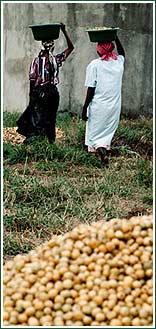|
|
 |
|
|
|

The Marula bears small round shaped fruit; (green in colour when unripe) that ripens to a yellow colour and can be harvested by being collected from the ground from January to March. According to Matt Marten operations manager of MNP, an analysis of the ripe fruit in the 2004 season yielded the following results: Average weight of 19.6g, peel of 31.6 %, stone 33.7% and pulp of 34.7%. The pulp is used as a base for juices, jams, jellies, ciders and alcohol drinks. The peel of the fruit is believed to have more than 27 different kinds of flavours and contains ten newly-isolated volatile esters that may be able to be extracted for use in aromatherapy, homeopathic medicines and essential oils and the freeze dried pulp of the marula fruit can be used in a number of cosmetic applications. Other products are the marula tea and as flavourant for ice –creams, etc. The fruit pulp contains up to four times vitamin C than oranges. Even though this fruit is seasonal, it can be processed into pulp in large volumes and stored frozen for a period of over a year.
|
|
|